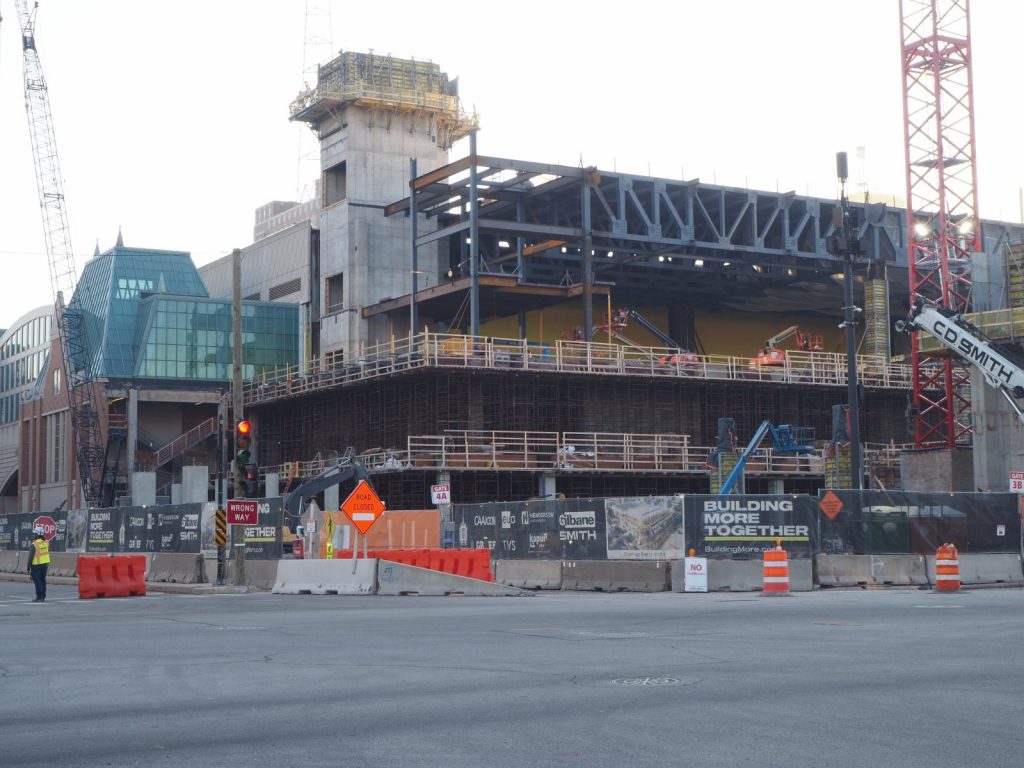Milwaukee Faces Construction Worker Shortage?
$3 billion in major projects planned or underway could face shortage, report says.
There are more than $3 billion in major construction projects planned or underway in Milwaukee, but are there enough workers to build them?
A new study from the Wisconsin Policy Forum (WPF) seeks to identify any possible workforce issues in the building trades while the Milwaukee area is under a sustained building boom, including 21 projects either planned or underway which are estimated to cost $50 million or more.
Five unions are predicting they won’t have enough journeyman workers to fill leadership in the coming years: roofers, painters, boilermakers and teamsters. Others warn that the pipeline of new workers isn’t sufficient to replace those who are eligible to retire.
Those that are working are busy. “Local pension fund data show that active union construction workers are being stretched to work considerably more hours on average than they were a decade ago,” says the report.
On the optimistic side, there are more apprentices than at any point in the last two decades and the majority of unions surveyed expect the number of apprentices to grow.
But those new hires are still likely to be white males.
“These issues have long been acknowledged, and efforts have been made to address them, but industry and local leaders may want to undertake additional steps,” write the authors, who suggest exploring expanding mentorship programs to pair journeyman workers with new apprentices of the same makeup.
Employment levels are nearing record highs. The total construction employment in the metropolitan area remains below its 2007 peak of 34,986 jobs, but has grown every year since 2012 and now stands at 32,826 jobs. That includes growing 0.6% from 2020 to 2021, during a period when Governor Tony Evers designated the sector an “essential service,” allowing it to grow through the pandemic. The pandemic growth bucked a broader trend where all metro-area employment fell by 5.1% from 2019 to 2021.
Construction unemployment in Wisconsin, as of June 2022, is 3.2%, below the national average of 3.7%. The largest number of workers are employed as carpenters, laborers, electricians and first-line supervisors.
Changes Needed To City Hiring Program?
The City of Milwaukee’s Residents Preference Program (RPP) aims to create jobs for city residents when public dollars are spent, and many private developments now seek to voluntarily comply with hiring targets.
But WPF found two issues with the program that could allow contractors to boost their numbers.
In its current form, the RPP policy calls for 40% of all project work hours to be completed by unemployed or underemployed city residents on virtually all public works projects and on private development projects when $1 million or more of city funds are to be provided.
A second provision in the city’s RPP ordinance allows contractors to claim credit for using RPP-certified workers on projects where RPP compliance is not required. City policy allows up to a third of RPP work hours to come from different projects.
That report does not make specific policy suggestions for city officials on how to amend the RPP ordinance. City officials have sought to find a legal pathway to include race or ethnicity in the RPP ordinance for several years, even since a prior effort was challenged.
The WPF study was sponsored by Gilbane Building Co. and Bader Philanthropies. Data came from the U.S. Bureau of Labor Statistics, Wisconsin Department of Workforce Development, Milwaukee Department of Public Works and Office of Equity and Inclusion, Building Trades United Pension Trust Fund and WRTP/BIG STEP.
The analysis was focused on commercial and multi-family housing projects, but the employment of workers on those projects has an impact on other areas, including infrastructure and single-family housing.
A copy of the report (PDF) is available on Urban Milwaukee.
If you think stories like this are important, become a member of Urban Milwaukee and help support real, independent journalism. Plus you get some cool added benefits.
Eyes on Milwaukee
-
Church, Cupid Partner On Affordable Housing
 Dec 4th, 2023 by Jeramey Jannene
Dec 4th, 2023 by Jeramey Jannene
-
Downtown Building Sells For Nearly Twice Its Assessed Value
 Nov 12th, 2023 by Jeramey Jannene
Nov 12th, 2023 by Jeramey Jannene
-
Immigration Office Moving To 310W Building
 Oct 25th, 2023 by Jeramey Jannene
Oct 25th, 2023 by Jeramey Jannene




















The priorities for many urban schools is to make students good multiple choice standardized test takers for all of the tests that that are used to rate schools by the State. One would think that with all of the focus on test taking schools that there are job for them as adult taking tests. Some schools and school districts are seeing the need to expose students to different vocational area and are engaging them on relevant hands on lessons/projects where they can experience working on some real world experiences. As long as Republicans can control the legislature in Madison, test score results will continue to dominate the evaluation of school systems.
conservatives rating schools on the results of multiple choice standardized tests